Taxation Law Assignment: Deductions, Credits, and Taxable Income
VerifiedAdded on 2020/04/01
|11
|2017
|116
Homework Assignment
AI Summary
This taxation law assignment provides detailed solutions to several scenarios. Answer 1 analyzes the deductibility of costs related to machinery movement, asset revaluation, and legal expenses in the context of Section 8-1 of the Income Tax Assessment Act 1997. Answer 2 addresses input tax credits for advertising expenses under the GST Act 1999. Answer 3 calculates a foreign tax offset for an individual with income from multiple countries, including employment, rental, dividend, and interest income. Finally, Answer 4 computes assessable income and allowable deductions for a partnership, including various income sources, GST, and deductible expenses such as interest, legal fees, salaries, and business lunches, providing a comprehensive overview of taxation principles and their application.
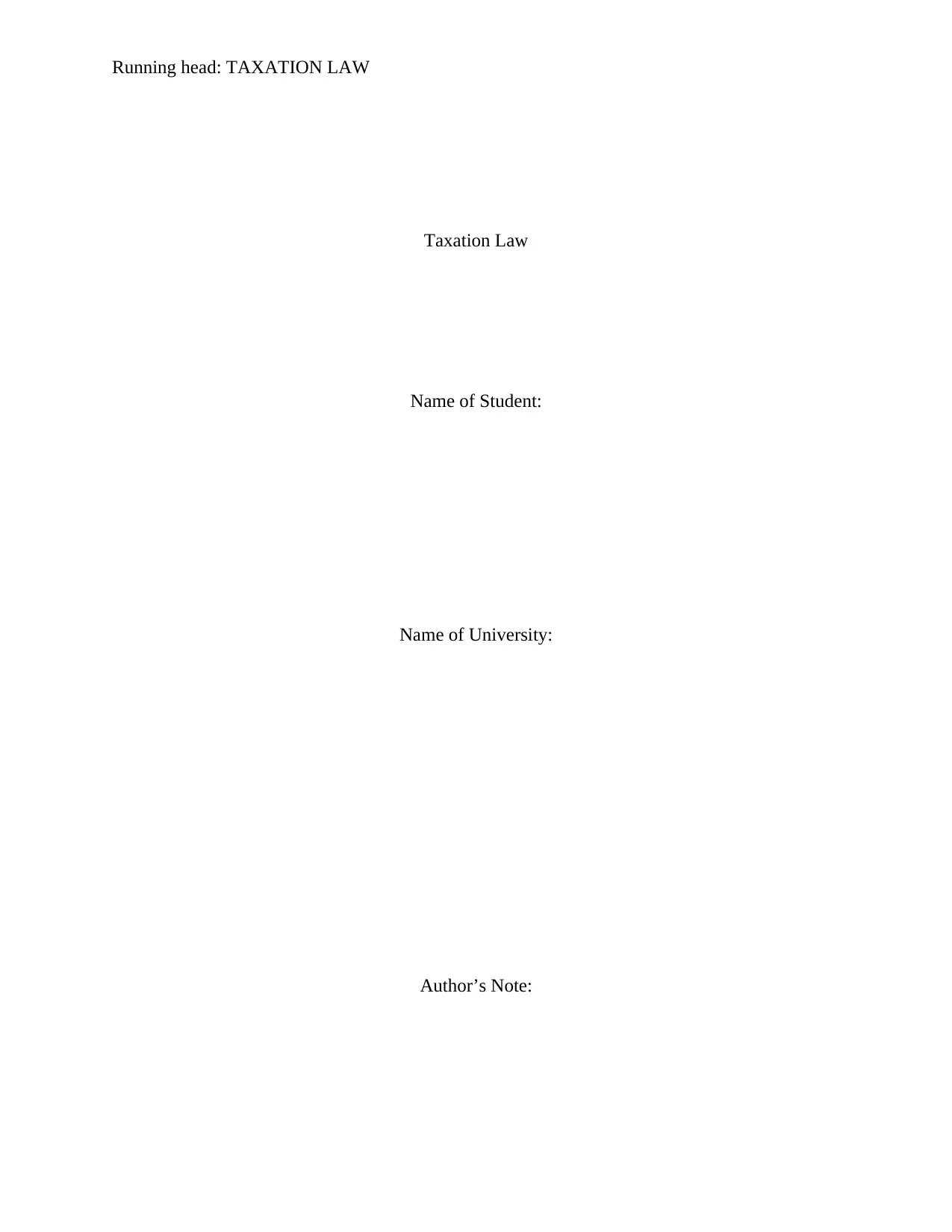
Running head: TAXATION LAW
Taxation Law
Name of Student:
Name of University:
Author’s Note:
Taxation Law
Name of Student:
Name of University:
Author’s Note:
Paraphrase This Document
Need a fresh take? Get an instant paraphrase of this document with our AI Paraphraser
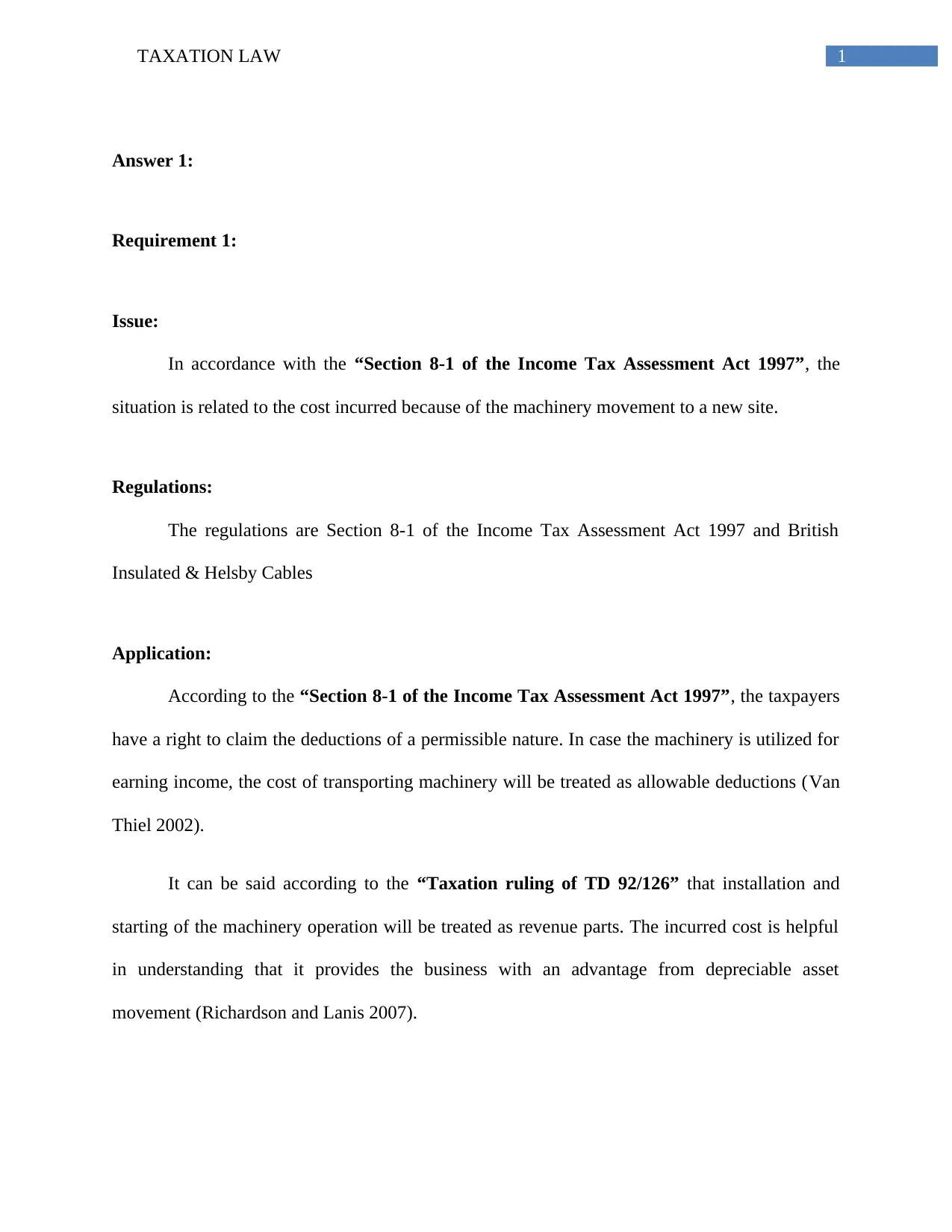
1TAXATION LAW
Answer 1:
Requirement 1:
Issue:
In accordance with the “Section 8-1 of the Income Tax Assessment Act 1997”, the
situation is related to the cost incurred because of the machinery movement to a new site.
Regulations:
The regulations are Section 8-1 of the Income Tax Assessment Act 1997 and British
Insulated & Helsby Cables
Application:
According to the “Section 8-1 of the Income Tax Assessment Act 1997”, the taxpayers
have a right to claim the deductions of a permissible nature. In case the machinery is utilized for
earning income, the cost of transporting machinery will be treated as allowable deductions (Van
Thiel 2002).
It can be said according to the “Taxation ruling of TD 92/126” that installation and
starting of the machinery operation will be treated as revenue parts. The incurred cost is helpful
in understanding that it provides the business with an advantage from depreciable asset
movement (Richardson and Lanis 2007).
Answer 1:
Requirement 1:
Issue:
In accordance with the “Section 8-1 of the Income Tax Assessment Act 1997”, the
situation is related to the cost incurred because of the machinery movement to a new site.
Regulations:
The regulations are Section 8-1 of the Income Tax Assessment Act 1997 and British
Insulated & Helsby Cables
Application:
According to the “Section 8-1 of the Income Tax Assessment Act 1997”, the taxpayers
have a right to claim the deductions of a permissible nature. In case the machinery is utilized for
earning income, the cost of transporting machinery will be treated as allowable deductions (Van
Thiel 2002).
It can be said according to the “Taxation ruling of TD 92/126” that installation and
starting of the machinery operation will be treated as revenue parts. The incurred cost is helpful
in understanding that it provides the business with an advantage from depreciable asset
movement (Richardson and Lanis 2007).
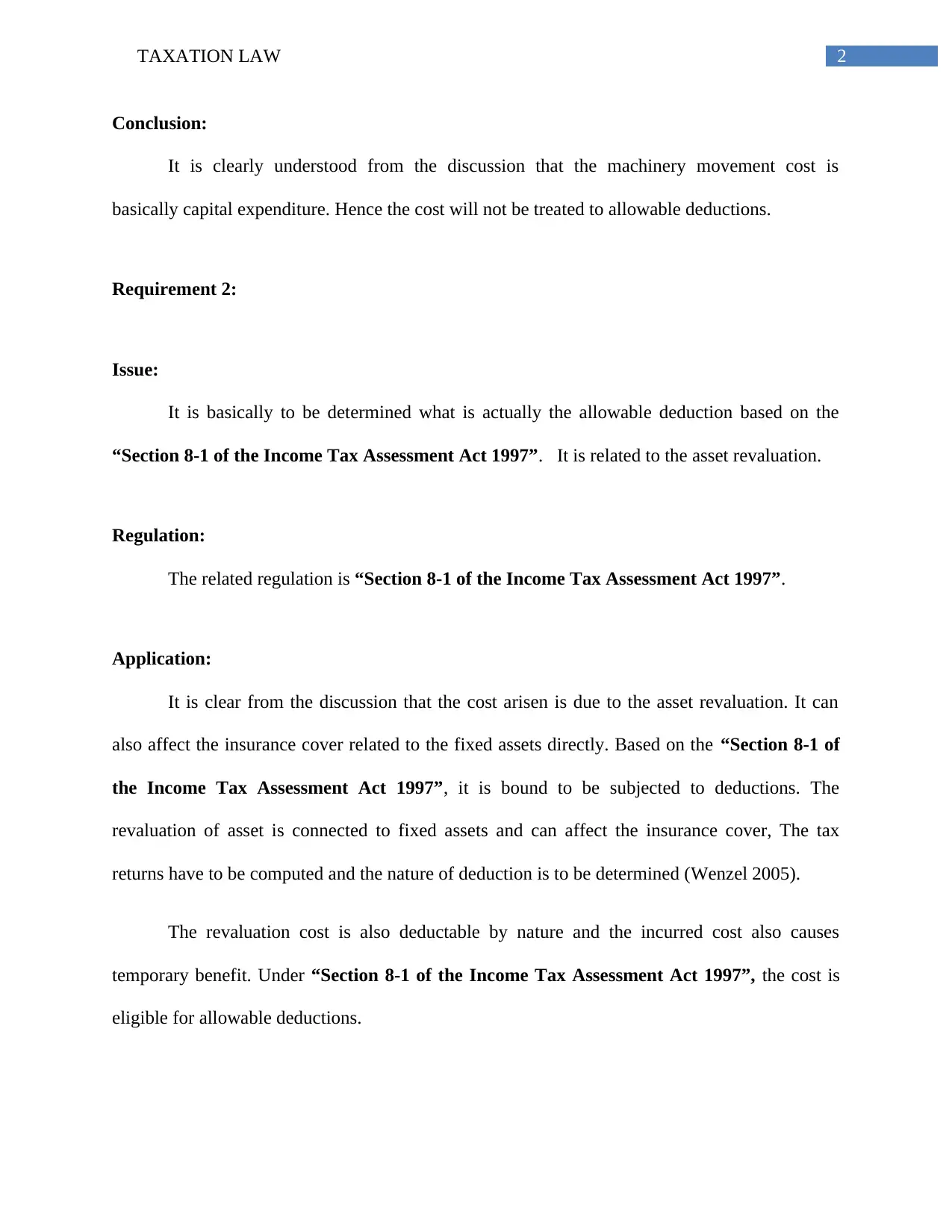
2TAXATION LAW
Conclusion:
It is clearly understood from the discussion that the machinery movement cost is
basically capital expenditure. Hence the cost will not be treated to allowable deductions.
Requirement 2:
Issue:
It is basically to be determined what is actually the allowable deduction based on the
“Section 8-1 of the Income Tax Assessment Act 1997”. It is related to the asset revaluation.
Regulation:
The related regulation is “Section 8-1 of the Income Tax Assessment Act 1997”.
Application:
It is clear from the discussion that the cost arisen is due to the asset revaluation. It can
also affect the insurance cover related to the fixed assets directly. Based on the “Section 8-1 of
the Income Tax Assessment Act 1997”, it is bound to be subjected to deductions. The
revaluation of asset is connected to fixed assets and can affect the insurance cover, The tax
returns have to be computed and the nature of deduction is to be determined (Wenzel 2005).
The revaluation cost is also deductable by nature and the incurred cost also causes
temporary benefit. Under “Section 8-1 of the Income Tax Assessment Act 1997”, the cost is
eligible for allowable deductions.
Conclusion:
It is clearly understood from the discussion that the machinery movement cost is
basically capital expenditure. Hence the cost will not be treated to allowable deductions.
Requirement 2:
Issue:
It is basically to be determined what is actually the allowable deduction based on the
“Section 8-1 of the Income Tax Assessment Act 1997”. It is related to the asset revaluation.
Regulation:
The related regulation is “Section 8-1 of the Income Tax Assessment Act 1997”.
Application:
It is clear from the discussion that the cost arisen is due to the asset revaluation. It can
also affect the insurance cover related to the fixed assets directly. Based on the “Section 8-1 of
the Income Tax Assessment Act 1997”, it is bound to be subjected to deductions. The
revaluation of asset is connected to fixed assets and can affect the insurance cover, The tax
returns have to be computed and the nature of deduction is to be determined (Wenzel 2005).
The revaluation cost is also deductable by nature and the incurred cost also causes
temporary benefit. Under “Section 8-1 of the Income Tax Assessment Act 1997”, the cost is
eligible for allowable deductions.
⊘ This is a preview!⊘
Do you want full access?
Subscribe today to unlock all pages.

Trusted by 1+ million students worldwide
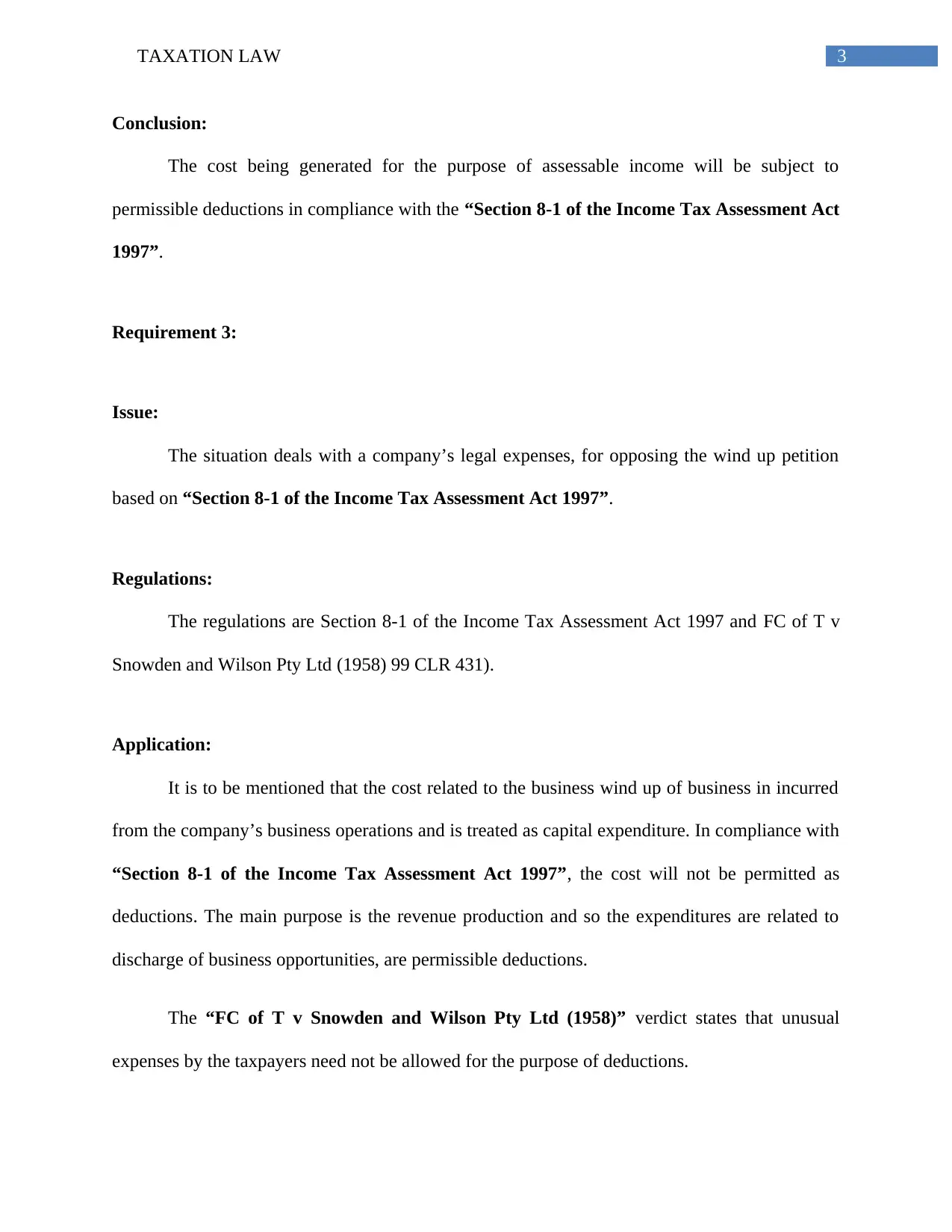
3TAXATION LAW
Conclusion:
The cost being generated for the purpose of assessable income will be subject to
permissible deductions in compliance with the “Section 8-1 of the Income Tax Assessment Act
1997”.
Requirement 3:
Issue:
The situation deals with a company’s legal expenses, for opposing the wind up petition
based on “Section 8-1 of the Income Tax Assessment Act 1997”.
Regulations:
The regulations are Section 8-1 of the Income Tax Assessment Act 1997 and FC of T v
Snowden and Wilson Pty Ltd (1958) 99 CLR 431).
Application:
It is to be mentioned that the cost related to the business wind up of business in incurred
from the company’s business operations and is treated as capital expenditure. In compliance with
“Section 8-1 of the Income Tax Assessment Act 1997”, the cost will not be permitted as
deductions. The main purpose is the revenue production and so the expenditures are related to
discharge of business opportunities, are permissible deductions.
The “FC of T v Snowden and Wilson Pty Ltd (1958)” verdict states that unusual
expenses by the taxpayers need not be allowed for the purpose of deductions.
Conclusion:
The cost being generated for the purpose of assessable income will be subject to
permissible deductions in compliance with the “Section 8-1 of the Income Tax Assessment Act
1997”.
Requirement 3:
Issue:
The situation deals with a company’s legal expenses, for opposing the wind up petition
based on “Section 8-1 of the Income Tax Assessment Act 1997”.
Regulations:
The regulations are Section 8-1 of the Income Tax Assessment Act 1997 and FC of T v
Snowden and Wilson Pty Ltd (1958) 99 CLR 431).
Application:
It is to be mentioned that the cost related to the business wind up of business in incurred
from the company’s business operations and is treated as capital expenditure. In compliance with
“Section 8-1 of the Income Tax Assessment Act 1997”, the cost will not be permitted as
deductions. The main purpose is the revenue production and so the expenditures are related to
discharge of business opportunities, are permissible deductions.
The “FC of T v Snowden and Wilson Pty Ltd (1958)” verdict states that unusual
expenses by the taxpayers need not be allowed for the purpose of deductions.
Paraphrase This Document
Need a fresh take? Get an instant paraphrase of this document with our AI Paraphraser
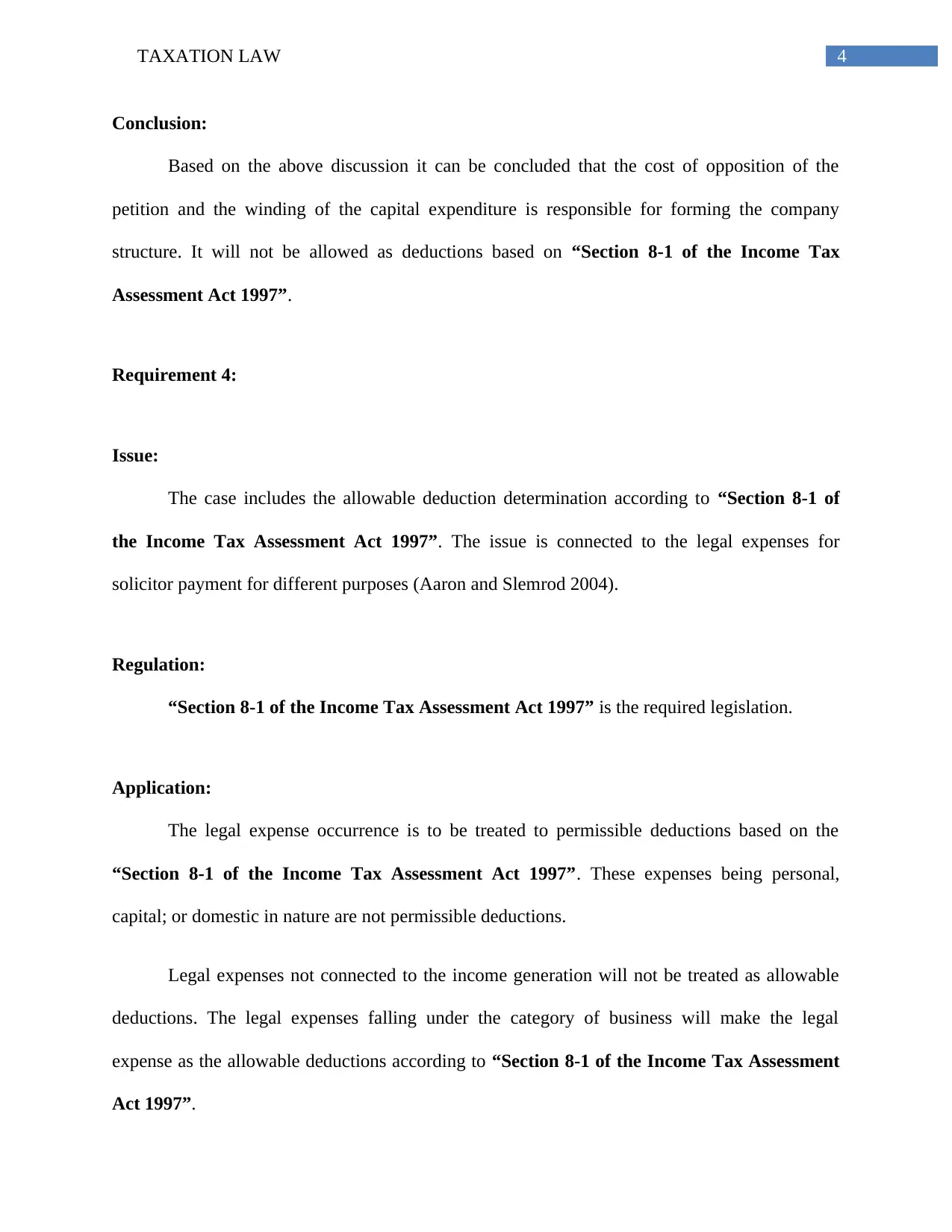
4TAXATION LAW
Conclusion:
Based on the above discussion it can be concluded that the cost of opposition of the
petition and the winding of the capital expenditure is responsible for forming the company
structure. It will not be allowed as deductions based on “Section 8-1 of the Income Tax
Assessment Act 1997”.
Requirement 4:
Issue:
The case includes the allowable deduction determination according to “Section 8-1 of
the Income Tax Assessment Act 1997”. The issue is connected to the legal expenses for
solicitor payment for different purposes (Aaron and Slemrod 2004).
Regulation:
“Section 8-1 of the Income Tax Assessment Act 1997” is the required legislation.
Application:
The legal expense occurrence is to be treated to permissible deductions based on the
“Section 8-1 of the Income Tax Assessment Act 1997”. These expenses being personal,
capital; or domestic in nature are not permissible deductions.
Legal expenses not connected to the income generation will not be treated as allowable
deductions. The legal expenses falling under the category of business will make the legal
expense as the allowable deductions according to “Section 8-1 of the Income Tax Assessment
Act 1997”.
Conclusion:
Based on the above discussion it can be concluded that the cost of opposition of the
petition and the winding of the capital expenditure is responsible for forming the company
structure. It will not be allowed as deductions based on “Section 8-1 of the Income Tax
Assessment Act 1997”.
Requirement 4:
Issue:
The case includes the allowable deduction determination according to “Section 8-1 of
the Income Tax Assessment Act 1997”. The issue is connected to the legal expenses for
solicitor payment for different purposes (Aaron and Slemrod 2004).
Regulation:
“Section 8-1 of the Income Tax Assessment Act 1997” is the required legislation.
Application:
The legal expense occurrence is to be treated to permissible deductions based on the
“Section 8-1 of the Income Tax Assessment Act 1997”. These expenses being personal,
capital; or domestic in nature are not permissible deductions.
Legal expenses not connected to the income generation will not be treated as allowable
deductions. The legal expenses falling under the category of business will make the legal
expense as the allowable deductions according to “Section 8-1 of the Income Tax Assessment
Act 1997”.
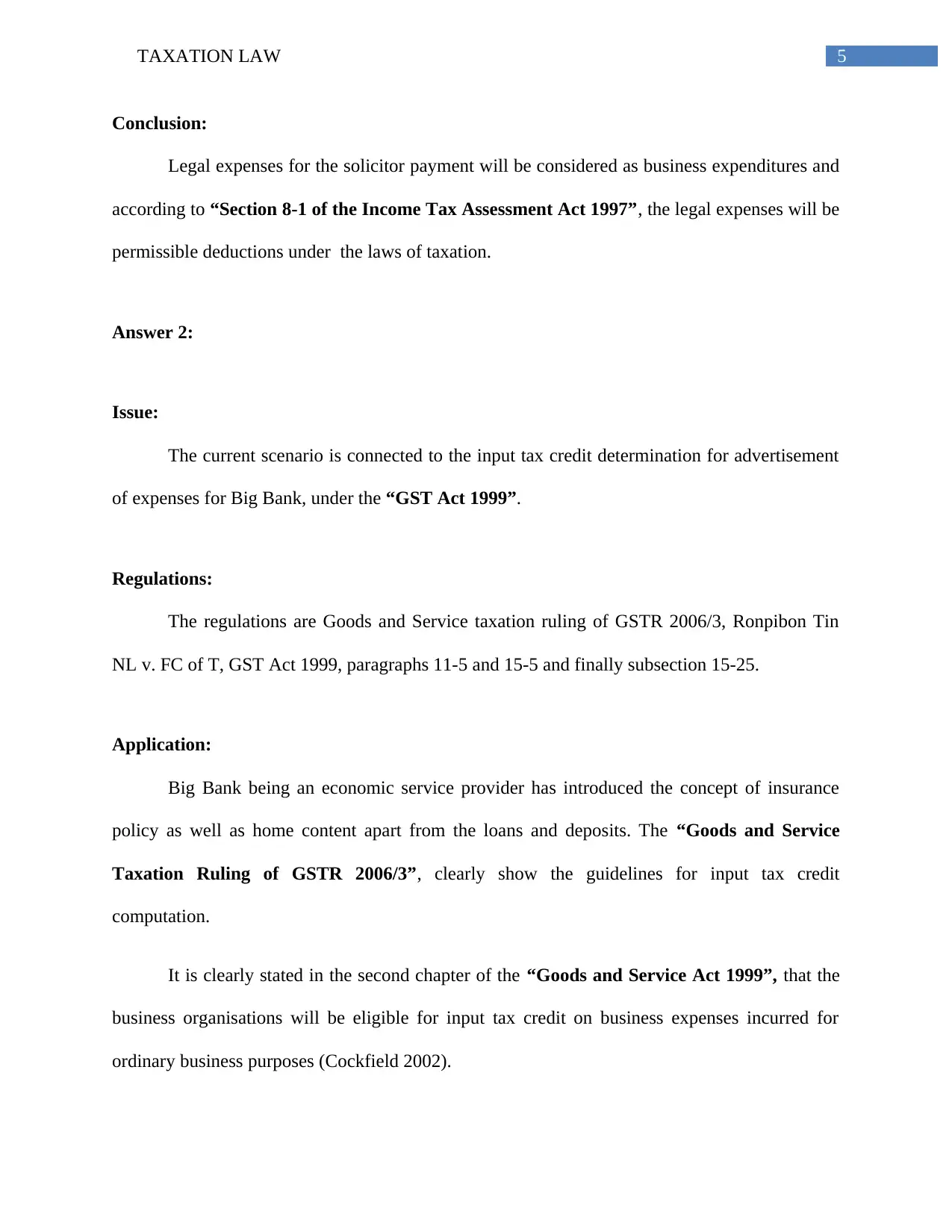
5TAXATION LAW
Conclusion:
Legal expenses for the solicitor payment will be considered as business expenditures and
according to “Section 8-1 of the Income Tax Assessment Act 1997”, the legal expenses will be
permissible deductions under the laws of taxation.
Answer 2:
Issue:
The current scenario is connected to the input tax credit determination for advertisement
of expenses for Big Bank, under the “GST Act 1999”.
Regulations:
The regulations are Goods and Service taxation ruling of GSTR 2006/3, Ronpibon Tin
NL v. FC of T, GST Act 1999, paragraphs 11-5 and 15-5 and finally subsection 15-25.
Application:
Big Bank being an economic service provider has introduced the concept of insurance
policy as well as home content apart from the loans and deposits. The “Goods and Service
Taxation Ruling of GSTR 2006/3”, clearly show the guidelines for input tax credit
computation.
It is clearly stated in the second chapter of the “Goods and Service Act 1999”, that the
business organisations will be eligible for input tax credit on business expenses incurred for
ordinary business purposes (Cockfield 2002).
Conclusion:
Legal expenses for the solicitor payment will be considered as business expenditures and
according to “Section 8-1 of the Income Tax Assessment Act 1997”, the legal expenses will be
permissible deductions under the laws of taxation.
Answer 2:
Issue:
The current scenario is connected to the input tax credit determination for advertisement
of expenses for Big Bank, under the “GST Act 1999”.
Regulations:
The regulations are Goods and Service taxation ruling of GSTR 2006/3, Ronpibon Tin
NL v. FC of T, GST Act 1999, paragraphs 11-5 and 15-5 and finally subsection 15-25.
Application:
Big Bank being an economic service provider has introduced the concept of insurance
policy as well as home content apart from the loans and deposits. The “Goods and Service
Taxation Ruling of GSTR 2006/3”, clearly show the guidelines for input tax credit
computation.
It is clearly stated in the second chapter of the “Goods and Service Act 1999”, that the
business organisations will be eligible for input tax credit on business expenses incurred for
ordinary business purposes (Cockfield 2002).
⊘ This is a preview!⊘
Do you want full access?
Subscribe today to unlock all pages.

Trusted by 1+ million students worldwide
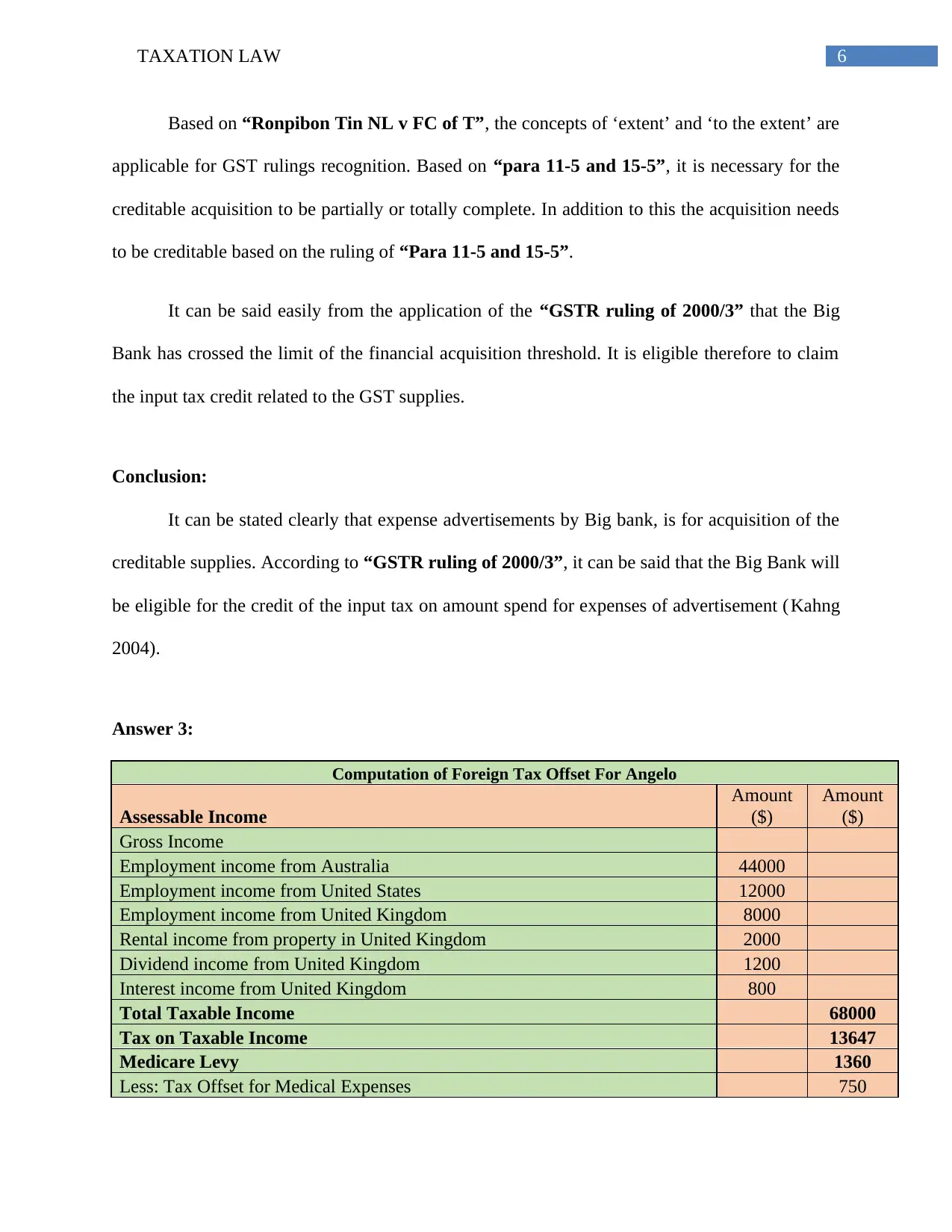
6TAXATION LAW
Based on “Ronpibon Tin NL v FC of T”, the concepts of ‘extent’ and ‘to the extent’ are
applicable for GST rulings recognition. Based on “para 11-5 and 15-5”, it is necessary for the
creditable acquisition to be partially or totally complete. In addition to this the acquisition needs
to be creditable based on the ruling of “Para 11-5 and 15-5”.
It can be said easily from the application of the “GSTR ruling of 2000/3” that the Big
Bank has crossed the limit of the financial acquisition threshold. It is eligible therefore to claim
the input tax credit related to the GST supplies.
Conclusion:
It can be stated clearly that expense advertisements by Big bank, is for acquisition of the
creditable supplies. According to “GSTR ruling of 2000/3”, it can be said that the Big Bank will
be eligible for the credit of the input tax on amount spend for expenses of advertisement (Kahng
2004).
Answer 3:
Computation of Foreign Tax Offset For Angelo
Assessable Income
Amount
($)
Amount
($)
Gross Income
Employment income from Australia 44000
Employment income from United States 12000
Employment income from United Kingdom 8000
Rental income from property in United Kingdom 2000
Dividend income from United Kingdom 1200
Interest income from United Kingdom 800
Total Taxable Income 68000
Tax on Taxable Income 13647
Medicare Levy 1360
Less: Tax Offset for Medical Expenses 750
Based on “Ronpibon Tin NL v FC of T”, the concepts of ‘extent’ and ‘to the extent’ are
applicable for GST rulings recognition. Based on “para 11-5 and 15-5”, it is necessary for the
creditable acquisition to be partially or totally complete. In addition to this the acquisition needs
to be creditable based on the ruling of “Para 11-5 and 15-5”.
It can be said easily from the application of the “GSTR ruling of 2000/3” that the Big
Bank has crossed the limit of the financial acquisition threshold. It is eligible therefore to claim
the input tax credit related to the GST supplies.
Conclusion:
It can be stated clearly that expense advertisements by Big bank, is for acquisition of the
creditable supplies. According to “GSTR ruling of 2000/3”, it can be said that the Big Bank will
be eligible for the credit of the input tax on amount spend for expenses of advertisement (Kahng
2004).
Answer 3:
Computation of Foreign Tax Offset For Angelo
Assessable Income
Amount
($)
Amount
($)
Gross Income
Employment income from Australia 44000
Employment income from United States 12000
Employment income from United Kingdom 8000
Rental income from property in United Kingdom 2000
Dividend income from United Kingdom 1200
Interest income from United Kingdom 800
Total Taxable Income 68000
Tax on Taxable Income 13647
Medicare Levy 1360
Less: Tax Offset for Medical Expenses 750
Paraphrase This Document
Need a fresh take? Get an instant paraphrase of this document with our AI Paraphraser
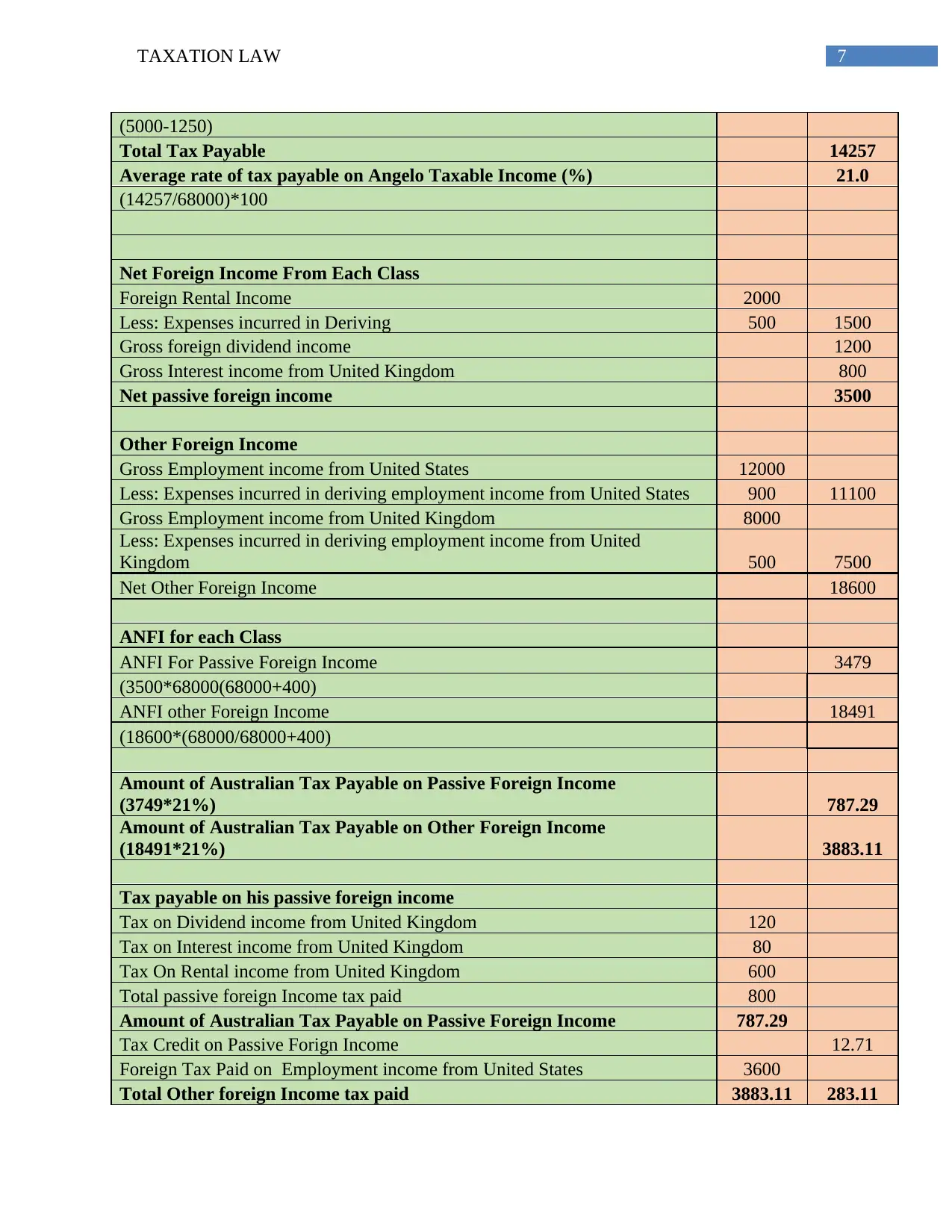
7TAXATION LAW
(5000-1250)
Total Tax Payable 14257
Average rate of tax payable on Angelo Taxable Income (%) 21.0
(14257/68000)*100
Net Foreign Income From Each Class
Foreign Rental Income 2000
Less: Expenses incurred in Deriving 500 1500
Gross foreign dividend income 1200
Gross Interest income from United Kingdom 800
Net passive foreign income 3500
Other Foreign Income
Gross Employment income from United States 12000
Less: Expenses incurred in deriving employment income from United States 900 11100
Gross Employment income from United Kingdom 8000
Less: Expenses incurred in deriving employment income from United
Kingdom 500 7500
Net Other Foreign Income 18600
ANFI for each Class
ANFI For Passive Foreign Income 3479
(3500*68000(68000+400)
ANFI other Foreign Income 18491
(18600*(68000/68000+400)
Amount of Australian Tax Payable on Passive Foreign Income
(3749*21%) 787.29
Amount of Australian Tax Payable on Other Foreign Income
(18491*21%) 3883.11
Tax payable on his passive foreign income
Tax on Dividend income from United Kingdom 120
Tax on Interest income from United Kingdom 80
Tax On Rental income from United Kingdom 600
Total passive foreign Income tax paid 800
Amount of Australian Tax Payable on Passive Foreign Income 787.29
Tax Credit on Passive Forign Income 12.71
Foreign Tax Paid on Employment income from United States 3600
Total Other foreign Income tax paid 3883.11 283.11
(5000-1250)
Total Tax Payable 14257
Average rate of tax payable on Angelo Taxable Income (%) 21.0
(14257/68000)*100
Net Foreign Income From Each Class
Foreign Rental Income 2000
Less: Expenses incurred in Deriving 500 1500
Gross foreign dividend income 1200
Gross Interest income from United Kingdom 800
Net passive foreign income 3500
Other Foreign Income
Gross Employment income from United States 12000
Less: Expenses incurred in deriving employment income from United States 900 11100
Gross Employment income from United Kingdom 8000
Less: Expenses incurred in deriving employment income from United
Kingdom 500 7500
Net Other Foreign Income 18600
ANFI for each Class
ANFI For Passive Foreign Income 3479
(3500*68000(68000+400)
ANFI other Foreign Income 18491
(18600*(68000/68000+400)
Amount of Australian Tax Payable on Passive Foreign Income
(3749*21%) 787.29
Amount of Australian Tax Payable on Other Foreign Income
(18491*21%) 3883.11
Tax payable on his passive foreign income
Tax on Dividend income from United Kingdom 120
Tax on Interest income from United Kingdom 80
Tax On Rental income from United Kingdom 600
Total passive foreign Income tax paid 800
Amount of Australian Tax Payable on Passive Foreign Income 787.29
Tax Credit on Passive Forign Income 12.71
Foreign Tax Paid on Employment income from United States 3600
Total Other foreign Income tax paid 3883.11 283.11
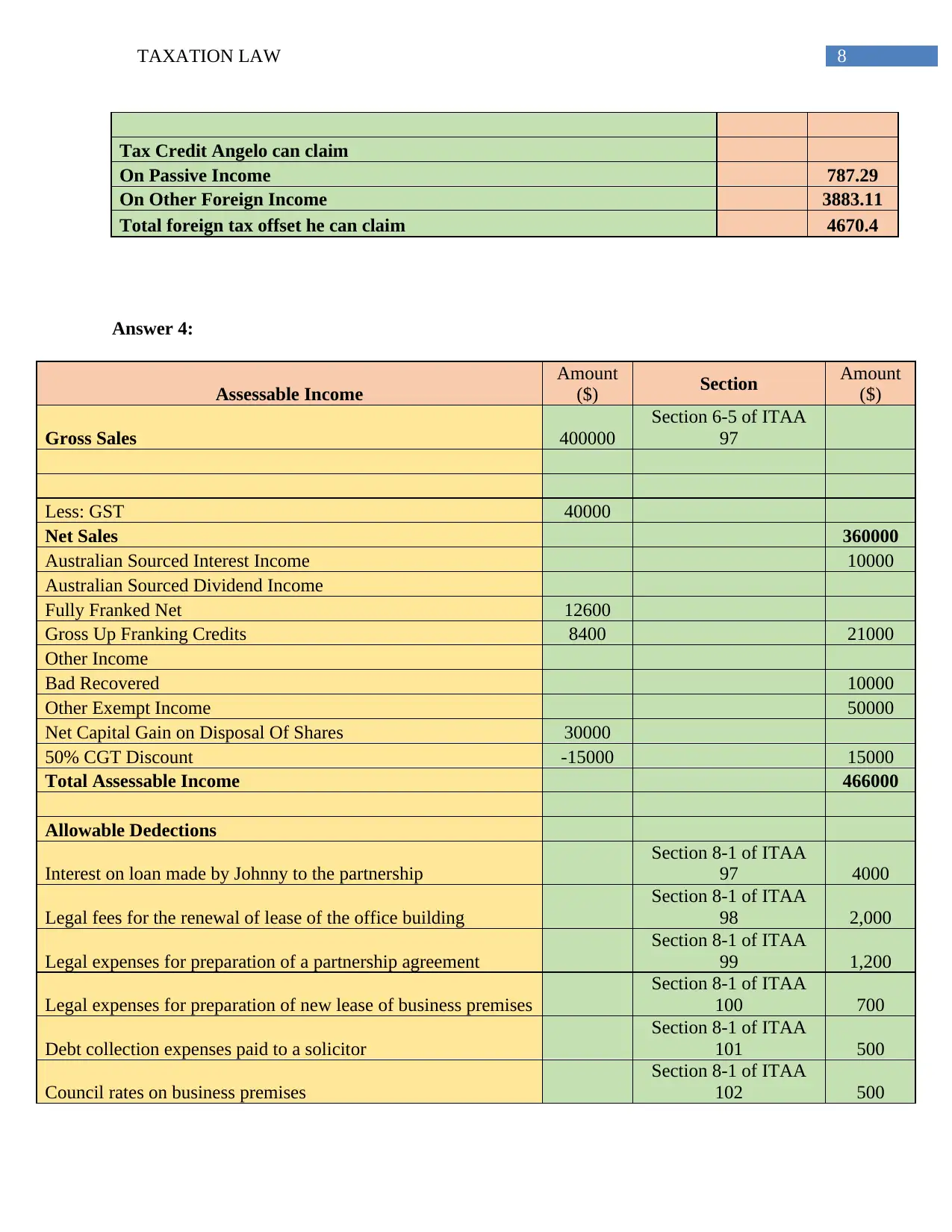
8TAXATION LAW
Tax Credit Angelo can claim
On Passive Income 787.29
On Other Foreign Income 3883.11
Total foreign tax offset he can claim 4670.4
Answer 4:
Assessable Income
Amount
($) Section Amount
($)
Gross Sales 400000
Section 6-5 of ITAA
97
Less: GST 40000
Net Sales 360000
Australian Sourced Interest Income 10000
Australian Sourced Dividend Income
Fully Franked Net 12600
Gross Up Franking Credits 8400 21000
Other Income
Bad Recovered 10000
Other Exempt Income 50000
Net Capital Gain on Disposal Of Shares 30000
50% CGT Discount -15000 15000
Total Assessable Income 466000
Allowable Dedections
Interest on loan made by Johnny to the partnership
Section 8-1 of ITAA
97 4000
Legal fees for the renewal of lease of the office building
Section 8-1 of ITAA
98 2,000
Legal expenses for preparation of a partnership agreement
Section 8-1 of ITAA
99 1,200
Legal expenses for preparation of new lease of business premises
Section 8-1 of ITAA
100 700
Debt collection expenses paid to a solicitor
Section 8-1 of ITAA
101 500
Council rates on business premises
Section 8-1 of ITAA
102 500
Tax Credit Angelo can claim
On Passive Income 787.29
On Other Foreign Income 3883.11
Total foreign tax offset he can claim 4670.4
Answer 4:
Assessable Income
Amount
($) Section Amount
($)
Gross Sales 400000
Section 6-5 of ITAA
97
Less: GST 40000
Net Sales 360000
Australian Sourced Interest Income 10000
Australian Sourced Dividend Income
Fully Franked Net 12600
Gross Up Franking Credits 8400 21000
Other Income
Bad Recovered 10000
Other Exempt Income 50000
Net Capital Gain on Disposal Of Shares 30000
50% CGT Discount -15000 15000
Total Assessable Income 466000
Allowable Dedections
Interest on loan made by Johnny to the partnership
Section 8-1 of ITAA
97 4000
Legal fees for the renewal of lease of the office building
Section 8-1 of ITAA
98 2,000
Legal expenses for preparation of a partnership agreement
Section 8-1 of ITAA
99 1,200
Legal expenses for preparation of new lease of business premises
Section 8-1 of ITAA
100 700
Debt collection expenses paid to a solicitor
Section 8-1 of ITAA
101 500
Council rates on business premises
Section 8-1 of ITAA
102 500
⊘ This is a preview!⊘
Do you want full access?
Subscribe today to unlock all pages.

Trusted by 1+ million students worldwide
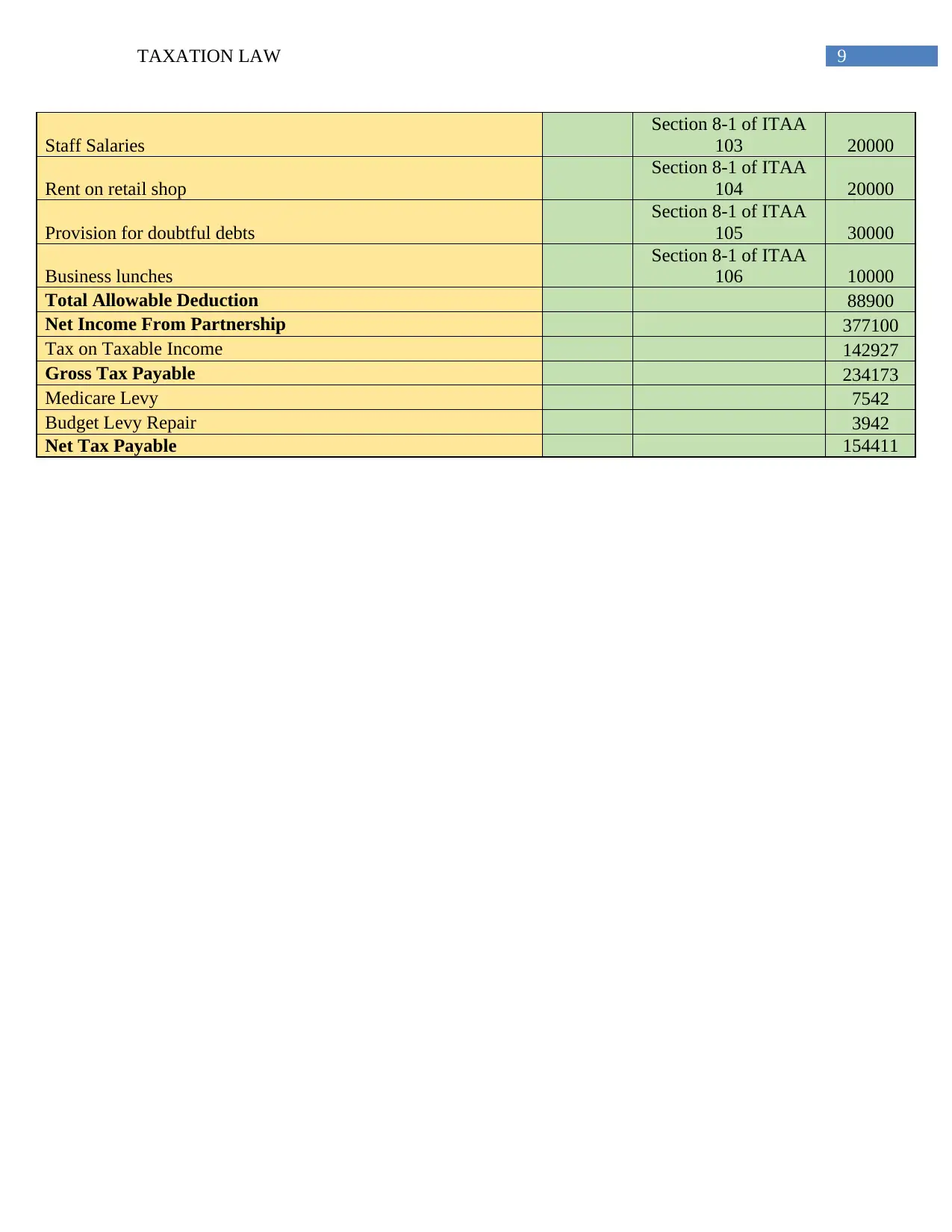
9TAXATION LAW
Staff Salaries
Section 8-1 of ITAA
103 20000
Rent on retail shop
Section 8-1 of ITAA
104 20000
Provision for doubtful debts
Section 8-1 of ITAA
105 30000
Business lunches
Section 8-1 of ITAA
106 10000
Total Allowable Deduction 88900
Net Income From Partnership 377100
Tax on Taxable Income 142927
Gross Tax Payable 234173
Medicare Levy 7542
Budget Levy Repair 3942
Net Tax Payable 154411
Staff Salaries
Section 8-1 of ITAA
103 20000
Rent on retail shop
Section 8-1 of ITAA
104 20000
Provision for doubtful debts
Section 8-1 of ITAA
105 30000
Business lunches
Section 8-1 of ITAA
106 10000
Total Allowable Deduction 88900
Net Income From Partnership 377100
Tax on Taxable Income 142927
Gross Tax Payable 234173
Medicare Levy 7542
Budget Levy Repair 3942
Net Tax Payable 154411
Paraphrase This Document
Need a fresh take? Get an instant paraphrase of this document with our AI Paraphraser
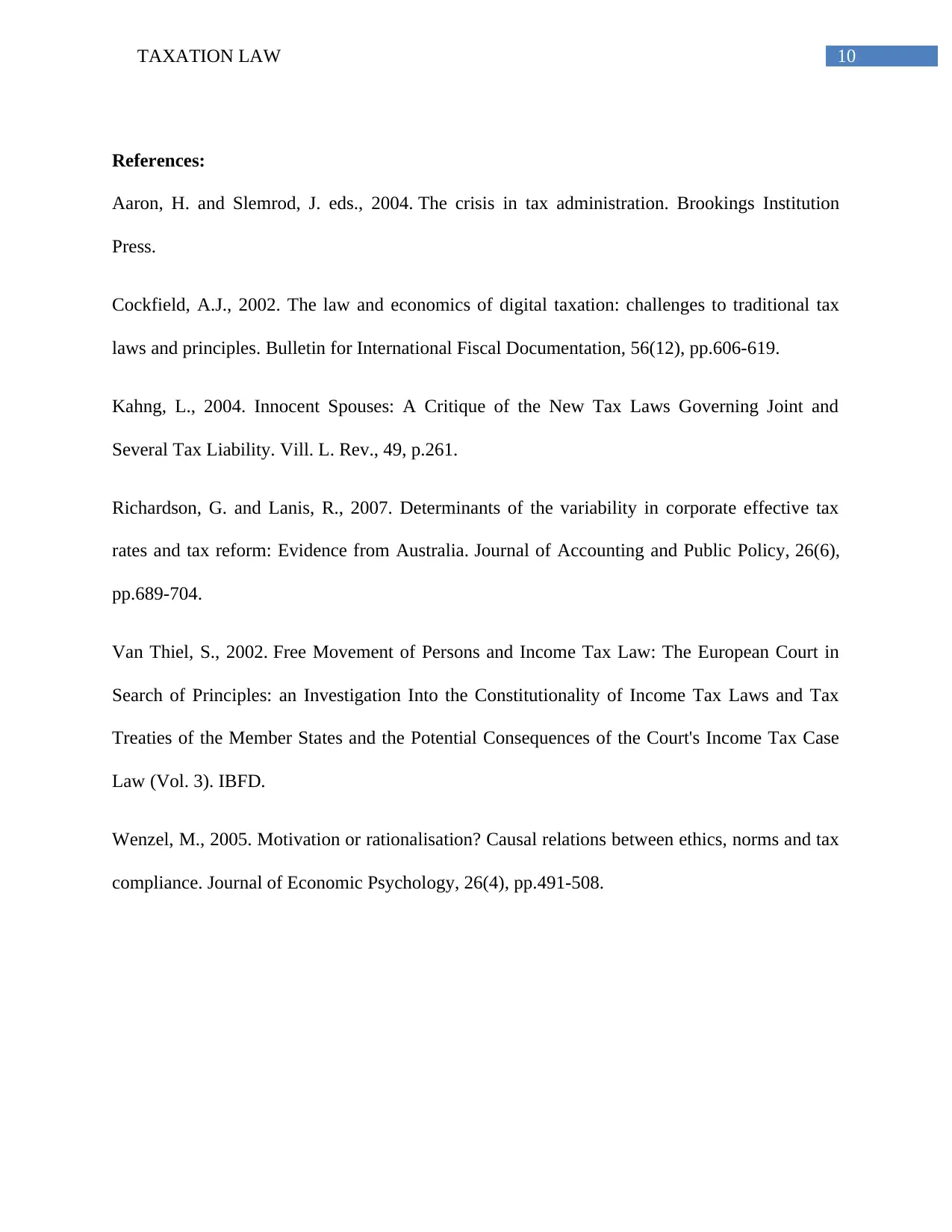
10TAXATION LAW
References:
Aaron, H. and Slemrod, J. eds., 2004. The crisis in tax administration. Brookings Institution
Press.
Cockfield, A.J., 2002. The law and economics of digital taxation: challenges to traditional tax
laws and principles. Bulletin for International Fiscal Documentation, 56(12), pp.606-619.
Kahng, L., 2004. Innocent Spouses: A Critique of the New Tax Laws Governing Joint and
Several Tax Liability. Vill. L. Rev., 49, p.261.
Richardson, G. and Lanis, R., 2007. Determinants of the variability in corporate effective tax
rates and tax reform: Evidence from Australia. Journal of Accounting and Public Policy, 26(6),
pp.689-704.
Van Thiel, S., 2002. Free Movement of Persons and Income Tax Law: The European Court in
Search of Principles: an Investigation Into the Constitutionality of Income Tax Laws and Tax
Treaties of the Member States and the Potential Consequences of the Court's Income Tax Case
Law (Vol. 3). IBFD.
Wenzel, M., 2005. Motivation or rationalisation? Causal relations between ethics, norms and tax
compliance. Journal of Economic Psychology, 26(4), pp.491-508.
References:
Aaron, H. and Slemrod, J. eds., 2004. The crisis in tax administration. Brookings Institution
Press.
Cockfield, A.J., 2002. The law and economics of digital taxation: challenges to traditional tax
laws and principles. Bulletin for International Fiscal Documentation, 56(12), pp.606-619.
Kahng, L., 2004. Innocent Spouses: A Critique of the New Tax Laws Governing Joint and
Several Tax Liability. Vill. L. Rev., 49, p.261.
Richardson, G. and Lanis, R., 2007. Determinants of the variability in corporate effective tax
rates and tax reform: Evidence from Australia. Journal of Accounting and Public Policy, 26(6),
pp.689-704.
Van Thiel, S., 2002. Free Movement of Persons and Income Tax Law: The European Court in
Search of Principles: an Investigation Into the Constitutionality of Income Tax Laws and Tax
Treaties of the Member States and the Potential Consequences of the Court's Income Tax Case
Law (Vol. 3). IBFD.
Wenzel, M., 2005. Motivation or rationalisation? Causal relations between ethics, norms and tax
compliance. Journal of Economic Psychology, 26(4), pp.491-508.
1 out of 11
Related Documents
Your All-in-One AI-Powered Toolkit for Academic Success.
+13062052269
info@desklib.com
Available 24*7 on WhatsApp / Email
![[object Object]](/_next/static/media/star-bottom.7253800d.svg)
Unlock your academic potential
Copyright © 2020–2025 A2Z Services. All Rights Reserved. Developed and managed by ZUCOL.





